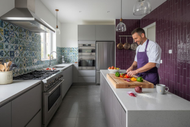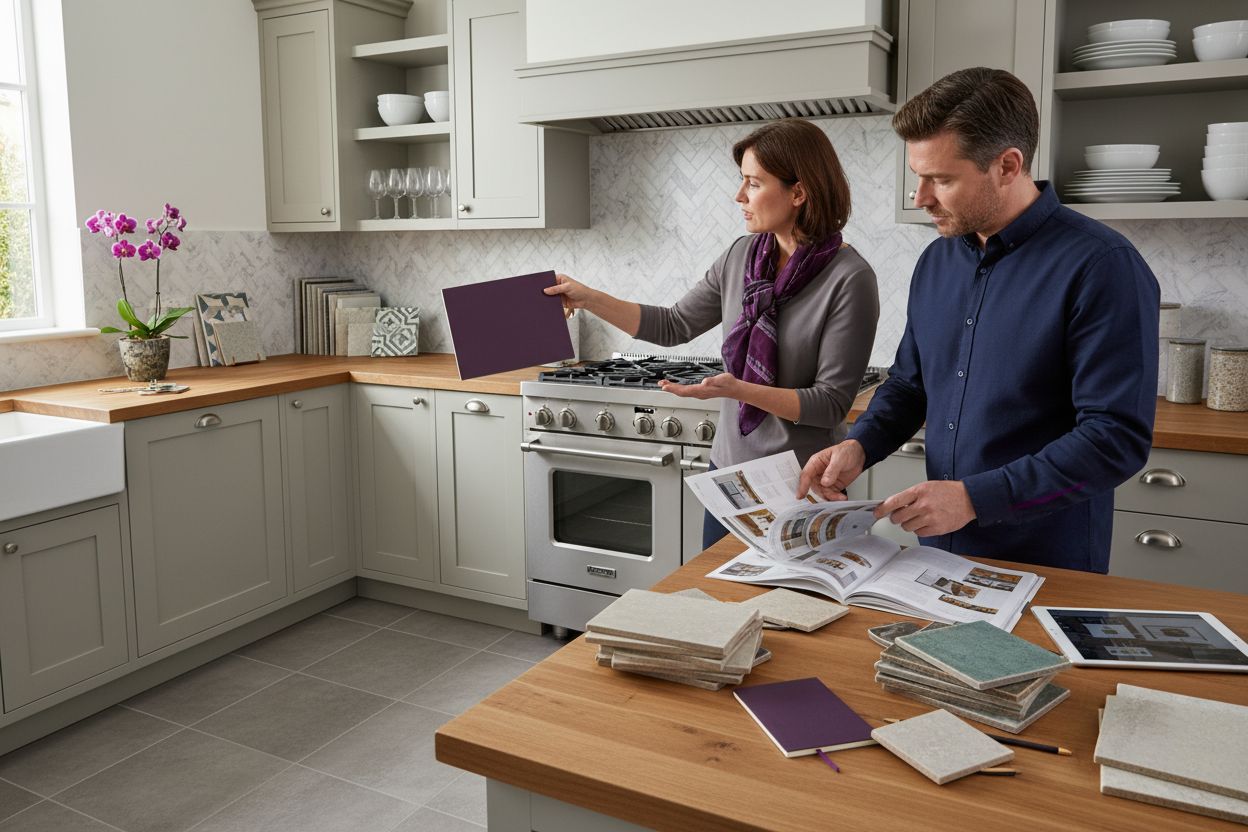Complete Guide to the Role of Tile in Kitchens
Posted by Mike Belk on Oct 21, 2025

Did you know that over 75 percent of kitchen renovations include new tile surfaces? The right tiles not only add character but also act as a practical shield against everyday mishaps in the busiest room of your home. Choosing the ideal kitchen tile impacts durability, hygiene, and long-term home value, making it a decision that shapes both your cooking experience and property appeal.
Key Takeaways
| Point | Details |
|---|---|
| Functionality of Tiles | Kitchen tiles are essential for durability, moisture protection, and cleanliness, contributing significantly to both functionality and aesthetic appeal. |
| Material Options | A variety of tile materials, such as ceramic, porcelain, and natural stone, serve distinct purposes, offering choices that balance beauty and resilience. |
| Design Versatility | Kitchen tiles offer extensive design possibilities through color, pattern, and texture, enabling homeowners to personalize their space. |
| Cost and Maintenance | Tile installation requires strategic budget planning, considering material costs and potential hidden expenses, alongside routine maintenance for longevity. |
Table of Contents
- Defining The Role Of Tile In Kitchens
- Types Of Kitchen Tiles And Applications
- Design Impact And Aesthetic Versatility
- Durability, Maintenance, And Lifespan
- Cost Considerations And Budget Planning
- Installation Methods And Common Mistakes
Defining the Role of Tile in Kitchens
Tiles in kitchens are far more than decorative surfaces—they are hardworking design elements that simultaneously protect, enhance, and transform culinary spaces. According to research from industry experts, kitchen tiles serve multiple critical functions beyond aesthetic appeal, providing practical solutions for durability, cleanliness, and long-term home value.
In kitchen environments, tiles play essential protective roles. Understanding the role of tiles in kitchen design reveals their primary functions include safeguarding surfaces against moisture, heat, and daily wear. According to flooring research, tile flooring specifically resists scratches, stains, and maintains structural integrity in high-traffic areas. This resilience makes tiles an ideal choice for spaces that experience constant activity and potential spills.
The versatility of kitchen tiles extends to multiple applications. Backsplash tiles, for instance, protect walls from heat, moisture, and cooking splatters while offering easy cleaning capabilities. Durable materials like ceramic, porcelain, glass, and stone not only preserve the kitchen’s appearance but also reduce the frequency of necessary repairs. By choosing the right tiles, homeowners can create spaces that are both visually appealing and functionally superior.
Beyond protection, kitchen tiles contribute significantly to a home’s aesthetic and market value. Their timeless appeal, combined with practical benefits like hygienic surfaces and easy maintenance, makes them an investment that transcends mere decoration. Whether used for flooring, backsplashes, or accent walls, tiles transform kitchens from simple cooking areas into stylish, resilient spaces that stand up to daily challenges.
Types of Kitchen Tiles and Applications
Kitchen tiles come in a diverse array of materials, each offering unique characteristics that make them suitable for different applications and design preferences. Ceramic tiles remain a popular choice, providing an affordable and versatile option for homeowners looking to balance functionality with aesthetic appeal.
Porcelain tiles stand out as a premium option for kitchen surfaces. According to research, these tiles are exceptionally dense and low-porosity, making them ideal for both wet and dry areas. Which types of tile are best for kitchen flooring reveals that porcelain tiles are vitrified, harder than ordinary ceramic tiles, and offer superior durability. Their remarkable resistance to moisture and wear makes them perfect for high-traffic kitchen environments.
Beyond porcelain and ceramic, homeowners can explore a range of tile options. Natural stone tiles like granite, marble, and slate bring unique textures and elegant aesthetics to kitchen spaces. Glass tiles offer a sleek, modern look and are particularly popular for backsplashes, providing a reflective surface that can make kitchens feel more spacious and bright. Specialty tiles including handmade ceramic, mosaic, and designer collections allow for personalized design expressions.
Each tile type serves specific functional and decorative purposes. Kitchen floor tiles need maximum durability and slip resistance, while backsplash tiles prioritize easy cleaning and visual impact. By understanding the characteristics of different tile materials, homeowners can make informed decisions that balance practical needs with design aspirations, transforming their kitchen into a beautiful and resilient space.

Here’s a comparison of common kitchen tile materials and their key characteristics:
![]()
| Tile Type | Durability | Maintenance | Typical Applications |
|---|---|---|---|
| Ceramic | Good | Easy | Floors Backsplashes |
| Porcelain | Excellent | Very Easy | Floors Walls Wet areas |
| Natural Stone | Very Good | Moderate to High | Floors Accent walls Backsplashes |
| Glass | Good | Easy | Backsplashes Accent areas |
Design Impact and Aesthetic Versatility
Tiles are more than just functional surfaces in kitchens—they are powerful design elements that can dramatically transform the entire visual landscape of a culinary space. Kitchen tiles offer an extraordinary range of design possibilities, acting as both a practical solution and a creative canvas for personal expression.
Color and pattern play crucial roles in tile design, allowing homeowners to create everything from subtle, understated backgrounds to bold, statement-making focal points. What is the Best Tile for Kitchen Backsplashes highlights how strategic tile selection can completely reshape a kitchen’s aesthetic. Neutral tones can create a sense of spaciousness and calm, while vibrant colors and intricate patterns can inject personality and energy into the cooking environment.
The versatility of tiles extends beyond color and pattern. Different tile layouts—such as herringbone, subway, or geometric arrangements—can create unique visual rhythms and architectural interest. Texture also plays a significant role, with options ranging from smooth, glossy surfaces that reflect light to rustic, textured tiles that add depth and tactile complexity to kitchen spaces.
Ultimately, kitchen tiles represent an intersection of art and function. They are not just surface coverings but design statements that reflect personal style, complement existing décor, and create a cohesive visual narrative. Whether aiming for a minimalist modern look, a warm traditional feel, or an eclectic artistic expression, the right tile selection can transform a kitchen from a mere cooking area into a truly personalized living space.
Durability, Maintenance, and Lifespan
Kitchen tiles represent a significant investment in home infrastructure, offering exceptional durability that far surpasses many alternative surface materials. Tile durability is determined by multiple factors, including material composition, manufacturing quality, and proper installation techniques, which collectively contribute to their remarkable longevity and performance in high-traffic kitchen environments.
Different tile materials showcase varying levels of resilience and maintenance requirements. 5 of the Best Type of Tile for Backsplash illustrates how ceramic and porcelain tiles excel in withstanding daily kitchen challenges. Porcelain tiles, in particular, demonstrate superior resistance to scratches, stains, and moisture, making them ideal for areas prone to spills, heat exposure, and constant cleaning.
Maintenance plays a critical role in extending tile lifespan. Regular cleaning with appropriate pH-neutral cleaners, prompt addressing of grout lines, and avoiding abrasive cleaning tools can significantly preserve tile appearance and structural integrity. Homeowners should implement routine maintenance strategies like sealing natural stone tiles, using soft microfiber cloths, and preventing standing water to minimize potential damage and maintain aesthetic appeal.
The long-term value of kitchen tiles extends beyond their physical durability. A well-maintained tile installation can last decades, potentially increasing home value and providing a timeless design element that withstands changing interior trends. By selecting high-quality tiles and implementing consistent care, homeowners can create kitchen surfaces that remain beautiful, functional, and resilient through years of daily use.
Cost Considerations and Budget Planning
Understanding the financial investment required for kitchen tiling is crucial for homeowners planning a renovation or design update. Kitchen tile projects encompass a wide range of cost considerations, from material selection to installation expenses, making comprehensive budget planning essential for a successful home improvement endeavor.
According to detailed research, kitchen tiling costs can vary dramatically. Material expenses range from $1 to $20+ per square foot, depending on the tile type and quality selected. Which Types of Tile are best for Kitchen Flooring highlights that labor costs typically add an additional $4 to $12 per square foot. This means a complete kitchen tiling project can range from $1,800 to $10,400, with total expenses influenced by factors like kitchen size, tile complexity, and potential substrate repairs.
Budget-conscious homeowners should consider several strategic approaches to manage costs. Mixing high-end accent tiles with more affordable base tiles can create visual interest while controlling overall expenses. Ceramic and porcelain tiles often provide the best balance between cost-effectiveness and durability, offering long-term value that justifies initial investment. Additional cost-saving strategies include purchasing tiles during sales, selecting standard sizes that reduce cutting waste, and considering DIY installation for those with moderate home improvement skills.
Beyond material and labor costs, smart budgeting involves anticipating hidden expenses. Substrate preparation, removal of existing flooring, grout and adhesive materials, and potential structural repairs can significantly impact the total project budget. Homeowners should typically allocate an additional 10-20% of the estimated cost for unexpected expenses, ensuring financial flexibility and preventing project delays.
Installation Methods and Common Mistakes
Successful kitchen tile installation requires more than just aesthetic selection—it demands precision, preparation, and technical understanding. Tile installation is a complex process that can make or break the entire kitchen renovation project, with each step presenting potential challenges that can compromise the final result.
Preparation is the foundation of successful tile installation. According to industry research, proper subfloor preparation involves removing old tiles, installing cement backer board (which costs approximately $5–$8 per square foot), and addressing any underlying structural issues. 5 of the Best Type of Tile for Backsplash emphasizes the critical nature of creating a smooth, level surface before tile placement. Professional installers recommend thorough cleaning, ensuring structural integrity, and using appropriate underlayment materials to prevent future complications.
Common installation mistakes can significantly impact the longevity and appearance of kitchen tiles. Grouting errors are particularly problematic, with issues ranging from uneven application to using incorrect grout types. Homeowners should be cautious about over-watering grout mix, applying grout too quickly, and neglecting to seal grout lines properly. These mistakes can lead to premature deterioration, moisture penetration, and compromised tile performance. Precise mixing, careful application, and appropriate sealing are essential to creating a durable and attractive tile surface.
Professional installation offers advantages that DIY approaches often cannot match. While labor costs average around $10 per square foot, experienced installers bring expertise in managing complex layouts, addressing substrate challenges, and ensuring proper alignment and spacing. For homeowners considering DIY installation, investing time in thorough research, acquiring proper tools, and understanding detailed installation techniques can help mitigate potential errors and achieve professional-quality results.
Transform Your Kitchen with Solutions that Last
After learning about the importance of tile durability, maintenance, and aesthetic versatility from our Complete Guide to the Role of Tile in Kitchens, you may be feeling the weight of choosing the perfect tile for your space. Concerns like finding resilient materials for a high-traffic kitchen, creating a beautiful backsplash, or sticking to a realistic budget are common pain points for homeowners and designers alike—all raised in the article. You want stylish options that hold up to daily wear and make cleaning simple, but confusing choices and installation mistakes can quickly derail your vision.
Ready to solve these challenges and bring your kitchen to life? Discover the BELK Tile collection, where you can browse a curated range of tile options for every kitchen need including glass mosaic, porcelain, ceramic, and natural stone. Each product is showcased with detailed images, pricing, and easy-to-use filtering tools so you can select your favorite style with confidence. Now is the perfect time to start your kitchen transformation—explore BELK Tile today and make your dream kitchen a reality.
Frequently Asked Questions
What are the primary functions of tiles in kitchens?
Tiles serve multiple critical functions in kitchens, including protecting surfaces from moisture, heat, and daily wear. They enhance durability, ensure easy cleaning, and contribute to the overall aesthetic and long-term value of the home.
What types of tiles are best for kitchen flooring?
Porcelain tiles are highly recommended for kitchen flooring due to their durability, moisture resistance, and low porosity. Ceramic tiles are also popular, while natural stone and glass tiles have specific applications, such as backsplashes and accent walls.
How do I maintain kitchen tiles to extend their lifespan?
To maintain kitchen tiles, regularly clean them with pH-neutral cleaners, promptly address grout lines, and avoid abrasive cleaning tools. Sealing natural stone tiles and preventing standing water are also important steps to minimize damage and maintain appearance.
What common mistakes should be avoided during tile installation in kitchens?
Common installation mistakes include improper subfloor preparation, uneven grout application, and neglecting to seal grout lines properly. Ensuring a smooth, level surface, using appropriate materials, and following precise installation techniques are essential for a successful tile project.



